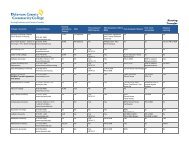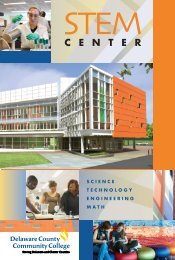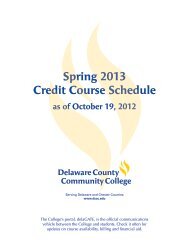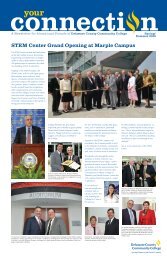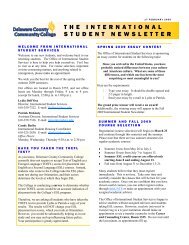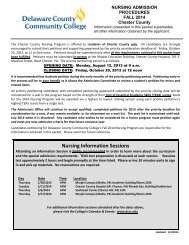2010 Catalog - Delaware County Community College
2010 Catalog - Delaware County Community College
2010 Catalog - Delaware County Community College
You also want an ePaper? Increase the reach of your titles
YUMPU automatically turns print PDFs into web optimized ePapers that Google loves.
COURSE DESCRIPTIONS 167<br />
• Present technical information concisely and accurately.<br />
• Demonstrate career-planning/job-seeking skills.<br />
• Enter and execute a basic program on a personal<br />
computer or calculator.<br />
3 Credits 1 Weekly Lecture Hours<br />
4 Weekly Laboratory Hours<br />
TME 210<br />
CNC Operations<br />
This course provides an introduction to the operation<br />
and manual programming of Computerized Numerically<br />
Controlled (CNC) machine tools including fundamental<br />
concepts, terminology and applications. The capabilities,<br />
advantages and disadvantages of numerically controlled<br />
equipment will be covered. Mathematical applications for<br />
definition of location, set-up, positioning and movement<br />
within specific coordinate systems will be presented.<br />
Various aspects of manual programming (G and M codes)<br />
and computerized conversational graphics modeling will<br />
be included. Criteria and practices basic to effective<br />
preventative maintenance, accident prevention practices<br />
and procedures, process planning, tooling, machine setup<br />
and operation (dry-run, first and production runs) will<br />
be addressed also.<br />
Upon successful completion of this course, students<br />
should be able to:<br />
• Develop an appreciation for the aspects of Numerical<br />
Control (NC) and for production enhancement<br />
capabilities of Computerized Numerically Controlled<br />
(CNC) machine tools.<br />
• Via manual methods, interpret and convert basic part<br />
drawings to procedural manufacturing process/operation,<br />
tooling and job plans for a CNC mill or a CNC lathe.<br />
• Apply principles of mathematics, engineering<br />
piece-part print interpretation and geometric analysis<br />
techniques to describe a manufactured part's datum<br />
points and planes, surfaces and feature locations in<br />
terms of two dimensional, interpolated machine axes<br />
and tooling positions.<br />
• Utilize the concepts and techniques of manual programming<br />
to prepare and proof a written manuscript for the<br />
production of a manufactured part on a CNC mill and a<br />
CNC lathe.<br />
• Demonstrate the ability to use concepts, techniques,<br />
hardware, software menus and computer system<br />
practices associated with a Computer Aided<br />
Machining/Distributed Numerical Control (DNC)<br />
system to write, save, retrieve and transfer CNC<br />
machine tool programs.<br />
• Conduct CNC mill and lathe set-up, dry run, first run,<br />
inspection and adjustment techniques, and production<br />
run procedures and practices.<br />
Prereq. TME 111<br />
3 Credits 2 Weekly Lecture Hours<br />
2 Weekly Laboratory Hours<br />
TME 212<br />
Computer Aided Machining<br />
This course provides students with and introduction to<br />
off-line programming of Computerized Numerically<br />
Controlled (CNC) machine tools via the use of Computer<br />
Aided Machining (CAM) software. Emphasis is placed on<br />
becoming comfortable and productive with a CAM system<br />
operated as an automated process modeling tool.<br />
Fundamental concepts terminology and applications are<br />
stressed, as is the use of interactive software modules for<br />
modeling CNC operations. Topics include an introduction<br />
to the computer/plotter/printer as a work station, an<br />
overview of graphics modeling concepts, the application's<br />
Graphical User Interface (GUI) and a thorough familizarion<br />
of selected icons and definitions. Generalized and specific<br />
activities associated with introductory computer-aided<br />
drafting (CAD)/CAM operations, job planning, piece-part<br />
geometry/tool path definition and part modeling will be<br />
covered. An introduction to workplanes and MACROs, as<br />
well as CNC code generation and machine communications,<br />
will be addressed. Milling and turning (with a minor<br />
emphasis on fabrication) operations will be stressed.<br />
Process modeling software packages for prod-uction<br />
milling and turning will be used as vehicles of instruction<br />
for this course.<br />
Upon successful completion of this course, students<br />
should be able to:<br />
• Develop the concepts necessary for interpretation<br />
and conversion of part drawings into proceduralized<br />
manufacturing process/operation, tooling sheets and<br />
job plans.<br />
• Use computer software and hardware (including<br />
peripherals) to interactively create, edit and communicate<br />
job plans (to include tooling/operational information),<br />
CAM generated drawings and machine code files.<br />
• Demonstrate a basic ability to transfer (and manipulate)<br />
2D CAD/CAM design data for use in piece-part process<br />
modeling and experimentation.<br />
• Formulate necessary logic (object/action techniques) and<br />
demonstrate knowledge of the software module's<br />
capabilities to define, create and edit drawings, and tool<br />
path elements using freeform and continuous part<br />
profile and surface creation techniques.<br />
• Complete activities associated with the verification of<br />
tool path motion, and for the creation of machine ready<br />
code, for piece-part production.<br />
• Utilize advanced software features to describe,<br />
manipulate and perform repetitive tasks associated with<br />
the creation of a manufacturing process model.<br />
• Conduct part program origin and<br />
workplane/transformations.<br />
Prereq. TME 111 Coreq. TCC 112<br />
3 Credits 2 Weekly Lecture Hours<br />
2 Weekly Laboratory Hours<br />
TME 216<br />
Statics and Strength of Material<br />
This course provides students with a foundation in the<br />
general procedures and principles of the mechanical design<br />
process. Students solve force systems select components<br />
and determine resultants in equilibrium. Strength failures<br />
of various materials will also be studied in detail.<br />
Upon successful completion of this course, students<br />
should be able to:<br />
• Analyze and solve problems involving force systems,<br />
components, resultants and equilibrium.<br />
• Determine center of gravity and centroids of members<br />
and objects.<br />
• Identify moment of inertia of objects.<br />
• Analyze simple structures under linear stress and strain.<br />
• Investigate the effects of torsion on shafts and springs.<br />
• Find the load, stress and deflection on beams.<br />
• Analyze structures subjected to combined loading.<br />
Prereq. MAT 111 and PHY 100<br />
4 Credits 3 Weekly Lecture Hours<br />
2 Weekly Laboratory Hours<br />
TME 220 Robotics and<br />
Programmable Controls<br />
This course provides an introduction to the field of<br />
robotics. The specific types of industrial robots their function<br />
and mode of operation will be addressed. The impact that<br />
programmable automation and the application of robotics<br />
is having on the worker, the workplace and on production<br />
planning will be discussed. Actuation and operational<br />
characteristics of robots will also be covered. A study of<br />
sensor and automation applications will be included.<br />
Upon successful completion of this course, students<br />
should be able to:<br />
• Discuss the effects that automation technology and<br />
industrial robots have on employers, employees and<br />
society in general.<br />
• Describe the basic structure and mechanical<br />
configuration as well as the functional characteristics of<br />
various types of robots.<br />
• Compare and contrast robotic/automated control systems<br />
.<br />
• List the end-of-arm-tooling characteristics available to<br />
the production planner.<br />
• Develop a list of accident prevention practices and<br />
procedures, and maintenance requirements for robotic<br />
work-cell operations.<br />
• Explain the aspects of flexible applications inherent<br />
to a robot.<br />
• Define the areas in manufacturing conducive to the<br />
utilization of robots.<br />
Describe the operation of a PLC and prepare programs<br />
to effect automatic control of processes.<br />
Coreq. TME 229<br />
3 Credits 2 Weekly Lecture Hours<br />
2 Weekly Laboratory Hours<br />
TME 221<br />
Manufacturing Proccesses II<br />
A continuation of Manufacturing Processes I. This<br />
course includes practical experience in machine<br />
operations. Hot-working manufacturing processes<br />
including laboratory production of simple molds,<br />
cores, castings and weldments are introduced.<br />
Upon successful completion of this course, students<br />
should be able to:<br />
• Describe principles of the major manufacturing<br />
processes and operations.<br />
• Determine a plan for the layout, operation and quality<br />
check of chip-cutting (cold), forging and melting (hot)<br />
manufacturing processes.<br />
• Produce a plan, layout and quality check of products<br />
by manufacturing processes.<br />
• Form a product by casting.<br />
• Form a product by forging.<br />
• Perform basic heat-treating operations.<br />
• Fabricate a product by welding.<br />
Prereq. TME 121<br />
2 Credits 2 Weekly Lecture Hours<br />
2 Weekly Laboratory Hours<br />
TME 222 Advanced Computer<br />
Aided Machining<br />
This course provides introductory instruction on<br />
advanced piece-part modeling techniques of Computer-<br />
Aided Drafting/Design-Computer Aided Machining<br />
(CADD-CAM). A broad based instructional approach<br />
provides concepts necessary to applying process modeling<br />
techniques for both advanced milling and turning. Threedimensional<br />
(combined surface types) geometry and<br />
associated tool path coding on multiple work and tool<br />
planes will be covered. Advanced solutions for completing<br />
four-axis simultaneous turning and integrated mill/turn<br />
(C-Axis) and 'live' tooling operations for modern lathes<br />
will be included also. Process modeling software packages<br />
for advanced three-dimensional machining and advanced<br />
turning will be used in instruction for this course.<br />
Upon successful completion of this course students<br />
should be able to:<br />
• Describe the basic concepts and performance<br />
requirements for effecting translation and manipulation<br />
of Computer-Aided Drafting/Design to Computer-Aided<br />
Machining (CADD-CAM) data for Computer Numerically<br />
Controlled (CNC) program creation.<br />
• Complete advanced work and tool plane definition, and<br />
manipulate software functions to perform operational<br />
activities involving same.<br />
• Conduct four- and five-axis position and rotary axis<br />
modeling as well as CNC code generation.<br />
• Identify, create and perform operations on surface<br />
primitives and developed (3D composite) wireframe<br />
and surface geometry models.<br />
• Create job plans and 3D surface geometry tool<br />
path and associated CNC machine tool code for<br />
piece-part production.<br />
• Plan, create and program synchronized four-axis




